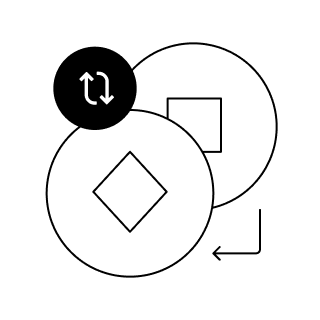What’s Kadena (KDA)? How can I buy it?
What is Kadena?
Kadena (KDA) is a Layer-1 blockchain platform designed to deliver high throughput, low transaction fees, and enterprise-grade security while preserving decentralization. Co-founded by Stuart Popejoy and Will Martino—former JPMorgan blockchain leads—Kadena aims to bridge the gap between scalable public blockchains and the needs of real-world businesses. Its core value proposition lies in combining a novel multi-chain architecture (Chainweb), a formally verifiable smart contract language (Pact), and a built-in mechanism for sustainable, low-fee transactions.
Kadena’s native token, KDA, is used to pay transaction fees (gas), incentivize miners, and secure the network. The ecosystem includes Kadena’s public Layer-1, a private blockchain offering for enterprise use cases, developer tooling, and a growing set of DeFi, NFT, and infrastructure integrations.
Key goals:
- High throughput without sacrificing security or decentralization
- Predictable, low fees and an approach to long-term fee sustainability
- Developer-friendly smart contracts with formal verification and upgrade safety
- Compatibility with enterprise and compliance requirements
How does Kadena work? The tech that powers it
Kadena’s technology stack centers on three pillars: Chainweb (execution and consensus), Pact (smart contracts), and a gas model designed for scalability and predictable costs.
- Chainweb: Parallelized Proof-of-Work with braided chains
- Multi-chain architecture: Instead of a single chain processing all transactions, Kadena runs multiple parallel Proof-of-Work (PoW) chains—each a fully featured blockchain—braided together via a cryptographic structure. Each block references not only its own chain’s history but also the headers of peer chains. This interlinking allows chains to simultaneously produce blocks and collectively secure the network.
- Security properties: By embedding peer-chain headers within each block, Chainweb distributes the security of PoW across all chains, making attacks more difficult without fragmenting security. The network’s overall security scales with the number of chains because miners must solve PoW across this braided structure.
- Throughput and scalability: Because chains operate in parallel, throughput increases as additional chains are added, without introducing a single global bottleneck. This is a fundamentally different approach to sharding or rollups; Chainweb keeps a single logical state space across multiple parallel chains via cross-chain proofs, enabling high transactional capacity while maintaining decentralization.
- Cross-chain communication: Kadena supports trust-minimized cross-chain transfers using SPV-like proofs between its braided chains. This built-in, native interop mechanism allows assets to move across chains without third-party bridges, reducing attack surface.
- Pact: Smart contracts with safety and governance built-in
- Human-readable, Turing-incomplete by design: Pact prioritizes safety and auditability over expressive complexity. Its Turing-incomplete nature reduces classes of bugs common in other smart contract languages, facilitating easier audits and formal reasoning.
- Formal verification: Pact includes built-in support for formal verification, allowing developers to mathematically prove properties about their contracts—such as invariants around token balances or permissioning rules—before deployment.
- On-chain governance and upgradability: Pact contracts support keysets (multi-signature/threshold controls) and versioning, enabling safe upgrades and controlled governance changes without resorting to proxy patterns that can obscure logic or permissions.
- Gas station model: Pact supports meta-transactions via “gas stations,” allowing dApps or enterprises to subsidize user transaction fees. This can create web2-like user experiences with no wallet gas friction for end users.
- Gas and economic design
- Low and predictable fees: Kadena’s parallel architecture and PoW throughput help keep fees low and predictable. The gas model aims to minimize fee spikes under load, which is critical for enterprise and consumer applications.
- Energy considerations: Although Kadena uses PoW, the parallelized design focuses on efficient throughput per unit of security and aims to align incentives for long-term sustainability. Kadena also emphasizes that high throughput at the base layer reduces reliance on energy-intensive layer-2 constructions or complex bridging.
- Mining and consensus
- Proof-of-Work: Kadena retains PoW for its established security and simplicity. The braided-Chains PoW approach distributes mining across multiple chains, with miners selecting chains to mine while still contributing to the overall network security.
- Difficulty and block timing: Each chain manages its own difficulty adjustments while remaining cryptographically linked to peers through cross-chain header references, aligning finality and chain quality across the braided set.
- Tooling and ecosystem
- Developer stack: Pact IDEs, command-line tools, and formal verification tooling lower the barrier to building secure smart contracts. The Kadena client libraries and APIs support web, server, and enterprise integrations.
- Interoperability: Native cross-chain transfers within Kadena, and bridges to external ecosystems via partners, broaden utility for assets and dApps.
- Enterprise solutions: Kadena also offers a private blockchain option, enabling businesses to build permissioned or hybrid applications that can interoperate with the public network where appropriate.
What makes Kadena unique?
- Chainweb’s multi-chain PoW: Kadena’s core innovation is scaling throughput by running many Proof-of-Work chains in parallel, braided via cryptographic links. Unlike sharding models that split state or rely on complex validator sets, Chainweb preserves Bitcoin-like security properties while scaling transaction capacity.
- Pact’s safety-first design: With formal verification, explicit governance primitives, and human-readable syntax, Pact reduces smart contract risk and operational complexity compared to Turing-complete languages. This is especially appealing for regulated industries and enterprises.
- Native cross-chain transfers: Kadena’s built-in SPV-like mechanism for cross-chain asset movement minimizes reliance on external bridges and their associated security risks.
- Gas station UX: The ability for applications or businesses to sponsor gas enables seamless user experiences akin to traditional apps, improving onboarding and retention.
- Enterprise pedigree: Founded by ex-JPMorgan blockchain leaders, Kadena targets real-world use cases with a blend of public and private chain offerings, regulatory-aware design, and production-grade tooling.
Kadena price history and value: A comprehensive overview
Note: Cryptocurrency markets are highly volatile. Verify all figures with up-to-date market data before making decisions.
- Early trading and listings: Kadena’s token, KDA, began trading publicly after its initial launch in 2019. Liquidity and exchange coverage expanded gradually as the ecosystem matured.
- 2021 bull cycle: KDA experienced a significant appreciation during the late-2021 market rally, reaching an all-time high (ATH) in the double-digit USD range amid broader market enthusiasm and increased attention on scalable L1s.
- 2022–2023 bear market: Like most crypto assets, KDA retraced substantially during the subsequent downturn, with valuations following macro risk sentiment, tightening liquidity, and recalibration of growth expectations.
- 2024 and beyond: Price action has continued to track broader market cycles, ecosystem development milestones (dApp launches, infrastructure integrations), and narratives around scalable PoW and enterprise blockchain adoption.
Determinants of value:
- Network usage: Transaction volume, active addresses, and dApp adoption can drive demand for KDA as gas.
- Developer traction: Growth in Pact-based applications and tooling.
- Exchange liquidity and listings: Accessibility affects retail and institutional participation.
- Macro and regulatory developments: Risk appetite, interest rates, and policy clarity influence valuations across the sector.
For precise, current price, market cap, and volume, consult reputable aggregators such as CoinGecko, CoinMarketCap, or exchange order books.
Is now a good time to invest in Kadena?
This is not financial advice. Consider the following factors and perform your own due diligence:
Potential advantages:
- Scalable base layer with strong security: Chainweb’s PoW model presents a differentiated path to throughput without complex validator economics.
- Developer and enterprise orientation: Pact’s formal verification and governance primitives are well-suited to high-stakes applications.
- User-centric fee model: Gas station capability can improve adoption by abstracting fees.
- Ecosystem growth optionality: If Kadena onboards meaningful dApps and enterprise use cases, network activity could strengthen demand for KDA.
Risks and considerations:
- Ecosystem maturity and competition: Kadena competes with established L1s and L2s (EVM and non-EVM) with larger developer networks and liquidity.
- Adoption curve: Realizing the benefits of Pact and Chainweb depends on continued developer education, tooling, and incentives.
- Market cyclicality: Crypto assets can experience large drawdowns; timing risk is significant.
- PoW narrative headwinds: While secure, PoW faces scrutiny over energy usage; market narratives may favor PoS or modular/L2 architectures depending on the cycle.
Due diligence checklist:
- Review Kadena’s whitepapers and technical documentation (Chainweb and Pact specs).
- Track developer activity (GitHub repos, commit frequency, grant programs).
- Monitor on-chain metrics and ecosystem launches.
- Assess exchange liquidity and custody support if considering sizable positions.
- Diversify and size positions based on personal risk tolerance and investment horizon.
Bottom line: Kadena offers a technically compelling approach—parallelized PoW with formally verifiable smart contracts and user-friendly gas mechanics. Whether now is a good time to invest depends on your risk profile, conviction in Kadena’s adoption trajectory, and broader market conditions. Consider a staged allocation and continuous monitoring rather than an all-at-once entry.
Discover the different ways to buy crypto
Create an OKX account
Get verified
Start a trade
Enter an amount
Choose your payment method
Confirm your order
All done
Create an OKX account
Get verified
Start a trade
If Kadena isn’t available in the dropdown, purchase any of the available tokens and convert it to KDA.
Place a buy order
Complete your purchase
Receive your KDA
All done
Get the OKX app or Wallet extension
Set up your wallet
Fund your wallet
Find your next purchase
Note:
Tokens with the same symbol can exist on multiple networks or may be forged. Always double-check the contract address and blockchain to avoid interacting with the wrong tokens.
Trade your crypto on OKX DEX
Choose the token you’re paying with (e.g., USDT, ETH, or BNB), enter your desired trading amount, and adjust slippage if needed. Then, confirm and authorize the transaction in your OKX Wallet.
Limit order (optional):
If you’d prefer to set a specific price for your crypto, you can place a limit order in Swap mode.
Enter the limit price and trading amount, then place your order.
Receive your crypto
All done

Make informed decisions















